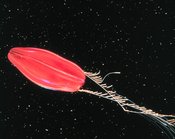Ctenophore
|
|
| Comb jellies | ||||
|---|---|---|---|---|
 | ||||
| Scientific classification | ||||
| ||||
| Classes | ||||
Ctenophores are jellyfish-like animals commonly called "comb jellies", "sea gooseberries", "sea walnuts", or "Venus' girdles." Comb jellies are voracious marine predators, feeding mostly on plankton. The word ctenophore (pronounced teen-oh-for) comes from Greek, kteno-, kteis, "comb" and -phore, meaning "comb-bearers". It comes via the New Latin ctenophorus in the 19th century.
Ctenophores are mainly composed of inert mesoglea, which causes them to have a low rate of metabolism. Many species are bioluminescent. The name comb jelly comes from eight "comb rows" of fused cillia, called ctenes, which are arranged laterally along the sides of the animal and used primarily for locomotion. The ctenes of the ctenophores gives rise to a rainbow-like effect that is caused by scattering of light due to the beating of cillia, not because of bioluminescence. The ctenophores are hermaphroditic, and some species can reproduce asexually. Most ctenophores have two long tentacles, but some lack tentacles completely. The tentacles have adhesive structures called colloblasts, or lasso cells. These cells burst open when prey comes in contact with the tentacle. Sticky threads released from each of the colloblasts will then capture the food. Some species have their entire body surface covered with sticky mucous that captures prey.
There are about 100 modern species of these marine animals. One of the most familiar genus of ctenophore is Mnemiopsis. Due to their soft and fragile bodies, the fossil record for comb jellies is poor. One possible ctenophore is known from the Middle Cambrian period.
External links
- Introduction to Ctenophora (http://www.ucmp.berkeley.edu/cnidaria/ctenophora.html)de:Rippenquallen
